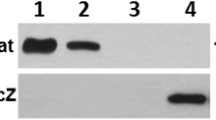Abstract
In extraintestinal pathogenic Escherichia coli (ExPEC) strains, mutation in the PstSCAB inorganic phosphate transporter results in multiple sensitivity phenotypes and loss of virulence. Here, we show that a pst mutant is subject to an increased outer membrane permeability and that pst copy number influences fatty acids regulation. Such perturbations are likely to participate in the impaired response of pst mutants to their environment.
Similar content being viewed by others
References
Aguena M, Spira B (2009) Transcriptional processing of the pst operon of Escherichia coli. Curr Microbiol 58:264–267
Angus BL, Carey AM, Caron DA et al (1982) Outer membrane permeability in Pseudomonas aeruginosa: comparison of a wild-type with an antibiotic-supersusceptible mutant. Antimicrob Agents Chemother 21:299–309
Crépin S, Lamarche MG, Garneau P et al (2008) Genome-wide transcriptional response of an avian pathogenic Escherichia coli (APEC) pst mutant. BMC Genomics 9:568
Cronan JE Jr (2002) Phospholipid modifications in bacteria. Curr Opin Microbiol 5:202–205
Cronan JE Jr, Rock CO (1996) Biosynthesis of membrane lipids. In: Neidhardt FC, Curtiss R III, Ingraham JL (eds) Escherichia coli and Salmonella: cellular and molecular biology. ASM Press, Washington, DC, pp 612–636
Daigle F, Fairbrother JM, Harel J (1995) Identification of a mutation in the pst-phoU operon that reduces pathogenicity of an Escherichia coli strain causing septicemia in pigs. Infect Immun 63:4924–4927
Lamarche MG, Kim SH, Mourez M et al (2008) Modulation of hexa-acyl pyrophosphate lipid A population under Escherichia coli phosphate (Pho) regulon activation. J Bacteriol 190:5256–5264
Lamarche MG, Wanner BL, Crépin S, Harel J (2008) The phosphate regulon and bacterial virulence: a regulatory network connecting phosphate homeostasis and pathogenesis. FEMS Microbiol Rev 32:461–473
Ngeleka M, Harel J, Jacques M, Fairbrother JM (1992) Characterization of a polysaccharide capsular antigen of septicemic Escherichia coli O115:K “V165”: F165 and evaluation of its role in pathogenicity. Infect Immun 60:5048–5056
Paisley R (1999) Cell culture techniques: extraction procedure. In: Paisley R (ed) MIS whole cell fatty acid analysis by gas chromatography, training manual. Midi Inc, Newark, Delaware, pp D1–D20
Ruiz N, Silhavy TJ (2003) Constitutive activation of the Escherichia coli Pho regulon upregulates rpoS translation in an Hfq-dependent fashion. J Bacteriol 185:5984–5992
Schurdell MS, Woodbury GM, McCleary WR (2007) Genetic evidence suggests that the intergenic region between pstA and pstB plays a role in the regulation of rpoS translation during phosphate limitation. J Bacteriol 189:1150–1153
Spira B, Yagil E (1998) The relation between ppGpp and the PHO regulon in Escherichia coli. Mol Gen Genet 257:469–477
Wanner B (1996) Phosphorus assimilation and control of the phosphate regulon. In: Neidhardt FC, Curtiss R III, Ingraham JL (eds) Escherichia coli and Salmonella: cellular and molecular biology. ASM Press, Washington, DC, pp 1357–1381
Wanner BL (1997) Phosphate signaling and the control of gene expression in Escherichia coli. In: Silver S, William W (eds) Metal ions in gene regulation. Chapman & Hall, New York, pp 104–128
Zhang YM, Rock CO (2008) Membrane lipid homeostasis in bacteria. Nat Rev Microbiol 6:222–233
Acknowledgements
We thank C. Uhland, Faculté de médecine vétérinaire, Université de Montréal, for using the GC facilities and his technical advice during this study and Céline Forget for preliminary work on GC. We also thank Philippe Garneau and Nicolas Bertrand for their work on qRT-PCR and antibiogram assays respectively. We are grateful to M. Mourez, Faculté de médecine vétérinaire, Université de Montréal, for his critical reading of the manuscript and technical advice during this study. M.G. Lamarche was supported by the Fonds québécois de la recherche sur la nature et les technologies (FQRNT). This work was supported by grants to J. Harel from the Natural Sciences and Engineering Research Council of Canada (RGPIN-25120).
Author information
Authors and Affiliations
Corresponding author
Rights and permissions
About this article
Cite this article
Lamarche, M.G., Harel, J. Membrane Homeostasis Requires Intact pst in Extraintestinal Pathogenic Escherichia coli . Curr Microbiol 60, 356–359 (2010). https://doi.org/10.1007/s00284-009-9549-x
Received:
Accepted:
Published:
Issue Date:
DOI: https://doi.org/10.1007/s00284-009-9549-x




